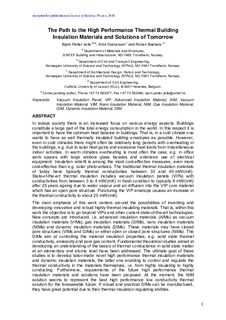The Path to the High Performance Thermal Building Insulation Materials and Solutions of Tomorrow
Journal article, Peer reviewed
Accepted version

Permanent lenke
http://hdl.handle.net/11250/2453116Utgivelsesdato
2010Metadata
Vis full innførselSamlinger
- Publikasjoner fra CRIStin - SINTEF AS [5801]
- SINTEF Community [2248]
Sammendrag
In todays society there is an increased focus on various energy aspects. Buildings constitute a large part of the total energy consumption in the world. In this respect it is important to have the optimum heat balance in buildings. That is, in a cold climate one wants to have as well thermally insulated building envelopes as possible. However, even in cold climates there might often be relatively long periods with overheating in the buildings, e.g. due to solar heat gains and excessive heat loads from miscellaneous indoor activities. In warm climates overheati ng is most often the case, e.g. in office work spaces with large window glass facades and extensive use of electrical equipment. Insulation retrofit is among the most cost-effective measures, even more cost-effective than e.g. solar photovoltaics. The traditional thermal insulation materials of today have typically thermal conductivities between 33 and 40 mW/(mK). State-of-the-art thermal insulation includes vacuum insulation panels (VIPs) with conductivities from between 3 to 4 mW/(mK) in fresh condition to typically 8 mW/(mK) after 25 years ageing due to water vapour and air diffusion into the VIP core material which has an open pore structure. Puncturing the VIP envelope causes an increase in the thermal conductivity to about 20 mW/(mK).
The main emphasis of this work centers around the possibilities of inventing and developing innovative and robust highly thermal insulating materials. That is, within this work the objective is to go beyond VIPs and other current state-of-the-art technologies. New concepts are introduced, i.e. advanced insulation materials (AIMs) as vacuum insulation materials (VIMs), gas insulation materials (GIMs), nano insulation materials (NIMs) and dynamic insulation materials (DIMs). These materials may have closed pore structures (VIMs and GIMs) or either open or closed pore structures (NIMs). The DIMs aim at controlling the material insulation properties, e.g. solid state thermal conductivity, emissivity and pore gas content. Fundamental theoretical studies aimed at developing an understanding of the basics of thermal conductance in solid state matter at an elementary and atomic level have been addressed. The ultimate goal of these studies is to develop tailor-made novel high performance thermal insulation materials and dynamic insulation materials, the latter one enabling to control and regulate the thermal conductivity in the materials themselves, i.e. from highly insulating to highly conducting. Furthermore, requirements of the future high performance thermal insulation materials and solutions have been proposed. At the moment, the NIM solution seems to represent the best high performance low conductivity thermal solution for the foreseeable future. If robust and practical DIMs can be manufactured, they have great potential due to their thermal insulation regulating abilities
Utgiver
SageTidsskrift
Journal of Building PhysicsOpphavsrett
This is the authors' accepted and refereed manuscript to the article. The final publication is available at http://www.dx.doi.org/10.1177/1744259110372782Beslektede innførsler
Viser innførsler beslektet ved tittel, forfatter og emneord.
-
Hollow Silica Nanospheres as Thermal Insulation Materials for Construction: Impact of their Morphologies as a Function of Synthesis Pathways and Starting Materials
Ng, Serina; Jelle, Bjørn Petter; Sandberg, Linn Ingunn Christie; Gao, Tao; Alex Mofid, Sohrab (Journal article; Peer reviewed, 2018)Hollow silica nanospheres (HSNS) show a promising potential to become good thermal insulators with low thermal conductivity values for construction purposes. The thermal conductivity of HSNSs is dependent on their structural ... -
Assessment of the Thermodynamic Stability of Thermal Insulating Materials in Aluminium Electrolysis Cells
Luneng, Raymond; Grande, Tor; Ratvik, Arne Petter (Journal article, 2016) -
Chemical Durability of Thermal Insulating Materials in Hall-Héroult Electrolysis Cells
Luneng, Raymond; Bertel, Søren N.; Mikkelsen, Jørgen; Ratvik, Arne Petter; Grande, Tor (Peer reviewed; Journal article, 2019)The most common thermal insulating materials used in the cathode lining in aluminum electrolysis cells are Moler (diatomaceous earth), calcium silicate, or vermiculite based materials. The thermal insulation layer is ...